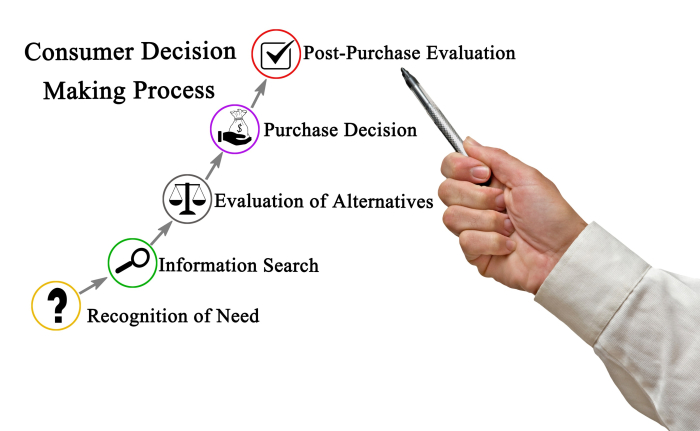
 Data Structure
Data Structure Networking
Networking RDBMS
RDBMS Operating System
Operating System Java
Java MS Excel
MS Excel iOS
iOS HTML
HTML CSS
CSS Android
Android Python
Python C Programming
C Programming C++
C++ C#
C# MongoDB
MongoDB MySQL
MySQL Javascript
Javascript PHP
PHP
- Selected Reading
- UPSC IAS Exams Notes
- Developer's Best Practices
- Questions and Answers
- Effective Resume Writing
- HR Interview Questions
- Computer Glossary
- Who is Who
How Do Consumers Make Purchase Decisions?
The end goal of any company is to sell its product and service to the consumer. Sales are the only part of the business that brings in revenue for the company. All the other wings or activities are cost-bearing activities for the business. Hence, it is important for firms and their sales and marketing executives to understand the consumer's decision-making process. The consumer decision-making process may seem like a subjective and mysterious thing, but we can divide it into five broad steps. These are the general steps that every consumer delves into before making a purchase decision.

Consumers' Decision-making Process
Consumers are considered to be rational human beings. They think before purchasing particular goods or services from the market. Consumers generally go through the decision-making process in the case of high-priced goods or goods in which they are invested. Consumers generally go through the decision-making process in the case of high-priced goods or goods in which they are invested. For example, mobile phones, refrigerators, expensive sports shoes, expensive cutlery, laptops, and others. The stages that a consumer goes through in their decision-making process can be classified into?
Problem Recognition - The setting stone for any purchase decision is analysis. Consumers have to feel the need for the product or service. The need can arise in two ways?
Internal Stimulus - In this case, the need for the product or service arises from within. For example, consumers might feel hunger, thirst, the need for shelter, and others. Hence, consumers make the purchase decision to satisfy these needs. The companies cannot generate internal stimulus.
External Stimulus - This happens when the need does not arise from within, but the customer is forced to feel the need for the product or service. This happens when they see their neighbors having a car or when they continuously see advertisements being run by the company for different products and services. For example, the consumer, because of the advertisements, may feel the need to have the newest version of the iPhone even though his current phone is doing well.

Information Search - After the need has been raised, the consumer starts searching for information. While searching for information about the product and the brand, they go through both external and internal information sources.
Internal information Gathering - Here the consumer considers his past experience with the brand and any information that has been shared with them by their close friends or relatives.
External information Gathering - Here the consumer starts searching about the company and the product on Google, social media, and other help sites. The consumer starts reading about the company and the experiences of its past users. Here, the job of the company is to ensure that they provide relevant information to potential buyers through their advertisements, websites, and social media handles.
The price of the product.
Features of the product.
Benefits of using the product.
Image of the company in front of the public as they will be investing a huge amount of their money.
Customer testimonials and others.
Alternative Evaluation - The consumer has gathered all of the information needed for the decision-making process of the various brands that offer the same or similar products. The consumer now starts comparing the products and the companies. Companies with higher social status may win over companies with more functional benefits. Companies can ensure that they are better than their competitors in the parameters that their customers will use to make a purchase decision. The factors might differ from consumer to consumer, but it will always be beneficial for companies to stay ahead. Here we can divide the comparison into two parts.
Functional advantages - there are objective characteristics of products that businesses can master by providing high-quality goods to their customers. For example, 2 GB of RAM is better than 3 GB of RAM.
Emotional or hedonic benefits - these are objective factors that customers may consider when making a purchase decision. For example, their social status might be enhanced by a BMW car rather than an Alto car. Alto might be pocket-friendly, offering the same features and benefits to the consumer but not the status that comes with money, hence BMW.
The consumers gather information like ?

Purchase decision - This is the most-awaited stage for the companies. Here, the consumer finally makes the purchase decision. After comparing the different brands and their benefits, consumers finally decided on their preferred brand. If a company has done everything right, they may have this experience often in their consumer journey.
Post-purchase evaluation or experience - many traditional companies feel that their job has been done once the 4th stage is completed or the consumer buys the product. These companies could not be more wrong. This is an era where the consumer is king, and hence it is important for businesses to ensure that the consumer is happy with the product or service after their purchase. Satisfied consumers come back for repeated purchases and also spread positive word of mouth for the company. The company can ensure that they have a good customer support team and that the queries of the customers are being resolved in 48 or 72 hours. Along with this, companies should also be ready to change or replace the product in case of defects. For example, every iPhone user can sell back their current iPhone at a good price to the Apple outlets when they purchase another model from the outlet.
Exceptions to the Consumer's Decision-making Process
After understanding in length the entire decision-making process of the consumer, let us now understand in what scenarios the decision-making process does not hold true.
For low-priced goods -Consumers will generally not go through the trouble of the entire process, like gathering information or comparing different brands, when the price of the good is low. Here, the consumer will purchase the goods that are readily available, have better packaging, or are better known in the market.
For repeat purchases - Consumers will not go through mental trouble with repeat purchases. When they have experimented with a brand or good and the product or service has met their expectations, they will purchase it next time without a second thought.

The theory that consumers are rational human beings does not hold true in cases of reckless or impulsive purchasing. - There could be scenarios when the consumer is purchasing recklessly. They see a product and buy it; that's the end of the story. In this case, the consumer is not going through the consumer decision-making process. This happens with both luxurious and necessary goods.
Nostalgic purchase - According to the nostalgic concept of marketing, consumers buy goods or services because they take them down memory lane. In simple terms, they are reminded of their past and their happy times. They purchase the product or service to have a similar kind of experience. Hence, in this case, as well, the consumer might not go through all the stages of the consumer decision-making process when they are buying the product.
It is very important for firms to understand the consumer decision-making process. Appropriate information, nudges in between through promotional activities, well-maintained websites, advertisements, and a strong digital presence can do wonders. We live in an era where the only thing that sells is what is visible. If companies take care of their consumers, the consumers will take care of the company.

